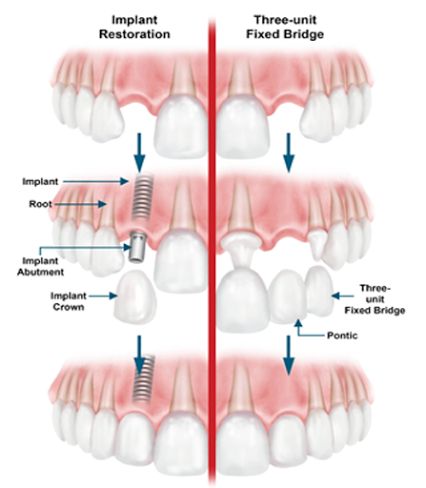+91-079-26421798
,+91 9825598120
For Appointment

Single tooth replacement
Multiple tooth replacement
All the teeth replacement in either upper or lower jaw
To support removable dentures
Most patients who are healthy and not restricted from undergoing minor dental surgical procedures, and who have good oral hygiene can have dental implants. Your dentist will assess the potential implant site to determine whether there is sufficient bone volume and gum thickness to allow the placement of an implant. We begin by undertaking a clinical examination that will involve inspection, palpation, and gentle probing of the potential implant site and adjacent teeth. In straightforward cases, simple dental x-rays are usually sufficient to examine the bone. In more complex cases, specialized implant x-rays, known as tomograms, are usually required (either plain x-rays or CAT scans).
Implants Functionality, it feels very much like natural teeth. For patients that have lived with removable appliances, you will feel much more secure with implant retained teeth versus your old removable teeth.
Most recent implant systems have a success rate of 90-98% for 10 years
Smoking is one of the biggest risk factors in failure of dental implants. Recent studies estimate that the chances of failure increase in a smoker.
Now a day's, an implant can be replaced if it fails to bond with the bone provided that adequate bone and gum tissue is present. Failures do not occur very often but they do occur.
Now a day's, existing dentures and other temporary appliances can be worn immediately after implant surgery. There are exceptions but our goal is to minimize any esthetic concerns during the healing phase
Now a day's, implants can be placed using local anesthesia in our office. In more complex cases, we may recommend that the surgical phase be performed while you are under sedation.
Sometimes if the quality and quantity of bone are adequate then immediate loading of implants can be possible where the final crown is given within 3-7 days.
Before beginning work on your jaw, Dr. Sheth uses a 3D CT Scan to capture an image of your jaw structure. With this data, sophisticated software creates a digital model of the shape of your mouth.


The All-on-4® treatment concept is a cost-efficient, graft less solution that provides patients with a fixed full-arch prosthesis on the day of surgery.
Full-arch rehabilitation with only four implants
Two straight anterior implants
and two implants tilted up to 45º in the posterior
Immediate Function (fixed provisional bridge)
For patients meeting criteria for
immediate loading of implants
Graft less procedure
Bone grafting is avoided by tilting the posterior implants,
utilizing available bone
The All-On-6® Dental Implant procedure creates a permanent prosthesis by using six dental implants. It acts as anchors for a bridge or over-denture. Six implants are positioned in the lower or upper jawbone to anchor prosthetic teeth in place permanently. After conducting a comprehensive examination using digital x-rays and a 3D Cone Beam CT-Scan, a dentist will evaluate the anatomical structures in the mouth. The dentist will then assess bone loss and create impressions to generate a new smile for you! Over time, the implants positioned in the jaw will fuse with the jawbone, representing the natural roots and giving back a natural smile.

Quick recovery
Enjoy eating and speaking again
Pearly white smile
No need for removable dentures
Instantly reverses age
You can bite and chew foods, just like natural teeth
Lifelong solution Dental implants are usually a permanent solution to missing teeth.
Bone grafting is rarely required
Easy home maintenance and cleaning
Delivers long-term results
Completely restored smile
Improves oral health
The simple procedure is low-cost and effective, making it an ideal choice. However, some may ask why they should choose All-on-6 as opposed to All-on-4? Neither of these options is necessarily better; it is a decision that should be made on a case-by-case basis. For example, if a more extensive reconstruction is needed, All-on-6 implants are a better choice because the additional implants provide additional support. However, if you do not have the additional bone mass required for the additional implants, you would be a more likely candidate for All-on-4.